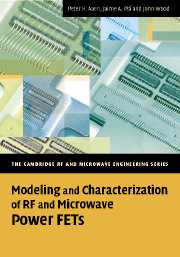Book contents
- Frontmatter
- Contents
- Preface
- Acknowledgments
- 1 RF and Microwave Power Transistors
- 2 Compact Modeling of High-Power FETs
- 3 Electrical Measurement Techniques
- 4 Passive Components: Simulation and Modeling
- 5 Thermal Characterization and Modeling
- 6 Modeling the Active Transistor
- 7 Function Approximation for Compact Modeling
- 8 Model Implementation in CAD Tools
- 9 Model Validation
- About the Authors
- Index
1 - RF and Microwave Power Transistors
Published online by Cambridge University Press: 19 August 2009
- Frontmatter
- Contents
- Preface
- Acknowledgments
- 1 RF and Microwave Power Transistors
- 2 Compact Modeling of High-Power FETs
- 3 Electrical Measurement Techniques
- 4 Passive Components: Simulation and Modeling
- 5 Thermal Characterization and Modeling
- 6 Modeling the Active Transistor
- 7 Function Approximation for Compact Modeling
- 8 Model Implementation in CAD Tools
- 9 Model Validation
- About the Authors
- Index
Summary
Introduction
While wireless communications standards may come and go with developments in the latest digital coding technology, or the liberation of new fragments of the electromagnetic spectrum, the common denominator among the various communications systems is the power amplifier. Over the last few decades, the transition from vacuum tubes and other forms of amplification to solid state devices has been almost complete, especially at power levels less than 1 kW. Nowadays, at the heart of the power amplifier, we find the power transistor.
In the world of RF wireless communications, the base-stations and long range transmitters use silicon LDMOS (laterally-diffused MOS) high power transistors almost exclusively. In addition to modern cellular communication systems, LDMOS devices are also used in a wide range of applications requiring radio-frequency power amplification: HF, VHF, and UHF communications systems; pulsed radar; industrial, scientific and medical (ISM) applications; avionics; and most recently in WiMAX™ communication systems. The frequency range of these applications is from a few megahertz and up to 4 GHz.
While LDMOS technology is pre-eminent in high-power RF and lower frequency microwave applications, a wide variety of compound (III–V) semiconductors are used as effective power amplification devices, especially for application frequencies above about 5 GHz, and also for lower power applications such as cellular handsets, Bluetooth™ and other wireless local area networks (WLANs), which generally demand output powers of about 1 watt or below.
- Type
- Chapter
- Information
- Publisher: Cambridge University PressPrint publication year: 2007



